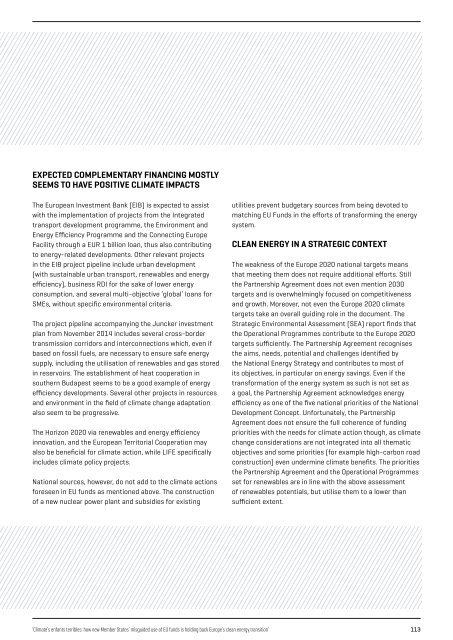ENFANTS TERRIBLES
enfants-terribles
enfants-terribles
Create successful ePaper yourself
Turn your PDF publications into a flip-book with our unique Google optimized e-Paper software.
EXPECTED COMPLEMENTARY FINANCING MOSTLY<br />
SEEMS TO HAVE POSITIVE CLIMATE IMPACTS<br />
The European Investment Bank (EIB) is expected to assist<br />
with the implementation of projects from the Integrated<br />
transport development programme, the Environment and<br />
Energy Efficiency Programme and the Connecting Europe<br />
Facility through a EUR 1 billion loan, thus also contributing<br />
to energy-related developments. Other relevant projects<br />
in the EIB project pipeline include urban development<br />
(with sustainable urban transport, renewables and energy<br />
efficiency), business RDI for the sake of lower energy<br />
consumption, and several multi-objective ‘global’ loans for<br />
SMEs, without specific environmental criteria.<br />
The project pipeline accompanying the Juncker investment<br />
plan from November 2014 includes several cross-border<br />
transmission corridors and interconnections which, even if<br />
based on fossil fuels, are necessary to ensure safe energy<br />
supply, including the utilisation of renewables and gas stored<br />
in reservoirs. The establishment of heat cooperation in<br />
southern Budapest seems to be a good example of energy<br />
efficiency developments. Several other projects in resources<br />
and environment in the field of climate change adaptation<br />
also seem to be progressive.<br />
The Horizon 2020 via renewables and energy efficiency<br />
innovation, and the European Territorial Cooperation may<br />
also be beneficial for climate action, while LIFE specifically<br />
includes climate policy projects.<br />
National sources, however, do not add to the climate actions<br />
foreseen in EU funds as mentioned above. The construction<br />
of a new nuclear power plant and subsidies for existing<br />
utilities prevent budgetary sources from being devoted to<br />
matching EU Funds in the efforts of transforming the energy<br />
system.<br />
CLEAN ENERGY IN A STRATEGIC CONTEXT<br />
The weakness of the Europe 2020 national targets means<br />
that meeting them does not require additional efforts. Still<br />
the Partnership Agreement does not even mention 2030<br />
targets and is overwhelmingly focused on competitiveness<br />
and growth. Moreover, not even the Europe 2020 climate<br />
targets take an overall guiding role in the document. The<br />
Strategic Environmental Assessment (SEA) report finds that<br />
the Operational Programmes contribute to the Europe 2020<br />
targets sufficiently. The Partnership Agreement recognises<br />
the aims, needs, potential and challenges identified by<br />
the National Energy Strategy and contributes to most of<br />
its objectives, in particular on energy savings. Even if the<br />
transformation of the energy system as such is not set as<br />
a goal, the Partnership Agreement acknowledges energy<br />
efficiency as one of the five national priorities of the National<br />
Development Concept. Unfortunately, the Partnership<br />
Agreement does not ensure the full coherence of funding<br />
priorities with the needs for climate action though, as climate<br />
change considerations are not integrated into all thematic<br />
objectives and some priorities (for example high-carbon road<br />
construction) even undermine climate benefits. The priorities<br />
the Partnership Agreement and the Operational Programmes<br />
set for renewables are in line with the above assessment<br />
of renewables potentials, but utilise them to a lower than<br />
sufficient extent.<br />
‘Climate’s enfants terribles: how new Member States’ misguided use of EU funds is holding back Europe’s clean energy transition’ 113


